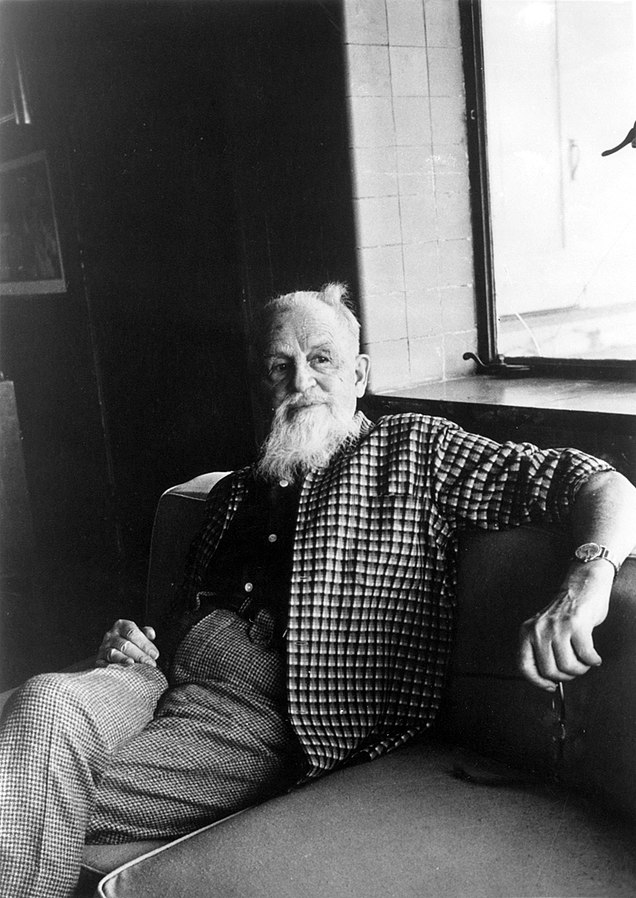Rex Stout (1 December 1886 - 7 October 1975) is one of America's best-known crime writers and the creator of Nero Wolfe, a mostly ill-tempered New York private detective with an exceptionally sharp intellect, a passion for growing orchids, good food and good books. Wolfe rarely leaves his apartment, and when he does, it is reluctantly. He relies on his assistant, Archie Goodwin, who is also the first-person narrator of the Nero Wolfe novels, to carry out his investigations.
This setup is, of course, reminiscent of Sherlock Holmes and Dr. Watson, and Traian Suttles, who reviewed Rex Stout's Gambit in the German chess magazine Karl, argues that
[h]ere we have a case of literary mourning: In July 1930, Arthur Conan Doyle, the creator of the universally respected and revered Sherlock Holmes, had died. ... For exactly four decades, from 1887 to 1927, Doyle's detective stories had profoundly shaped the genre of crime fiction. When it became irrevocably clear that there would be no more stories about the genius from Baker Street, Stout apparently felt compelled to continue the Holmes myth with a specially conceived successor character. (Traian Suttles, "Verlustreiches Gambit", Karl, 4/2022, p.52. My translation.)
It was a productive form of mourning. Stout's first Nero Wolfe novel, entitled 'Fer-de-Lance', was published in 1934, and by the time of his death in 1975, Stout had written 32 more Nero Wolfe novels and 41 other stories featuring the private detective. According to his diaries, Stout usually took six weeks to complete one of these novels, while shorter stories could be finished in two weeks.
It also was a successful form of mourning: In 1959 Stout was honoured with the Grand Master Award by the Mystery Writers of America, and at Bouchercon XXXI, the world's largest mystery convention, his Nero Wolfe series was voted the best mystery series of the century and Stout was voted the best mystery writer of the century.

Rex Stout 1975 | Photo source: Wikipedia
Chess is the central theme of Stout's novel Gambit, published in October 1962. Wolfe's task is to find out who poisoned the chess player Paul Jerin while he was performing a simultaneous blindfold exhibition on twelve boards. The police quickly suspect Matthew Blount, a wealthy businessman and president of the chess club where the blindfold exhibition took place. However, Blount's daughter Sally believes in her father's innocence and hires Wolfe to find the real killer. Wolfe soon realises that the murderer used Jerin as a pawn to frame Blount and take him out of the picture - that's the "gambit" of the title.
Since the murder took place in a chess club and both the victim and the main suspects are chess players, Wolfe and Goodwin's investigation naturally revolves around chess. In Chapter 3, Goodwin describes the luxurious furnishings of the chess club.
"In a corner was a chess table with a marble top, with yellow and brown marble for the squares, and the men spread around, not on their home squares. The Gazette had said that that the men were of ivory and Kokcha lapis lazuli and they and the table had belonged to and been played with by Louis XIV, and that the men were kept in the position after the ninth move of Paul Morphy's most famous game, his defeat of the Duke of Brunswick and Count Isouard in Paris in 1858." (Rex Stout, Gambit, William Collins Sons & Co Ltd, Glasgow 1975, first published 1963, p. 38.)
A diagram of the position after the ninth move, or even of the whole game, is missing from "Gambit", but here is the famous game again for you to replay - with notes by Bobby Fischer.
And while Goodwin observes a game being played at the chess club, he comes to this conclusion:
"A fascinating game if it fascinates you. With nothing better to do, I stuck with it for half an hour, deciding for both White and Black what the next move should be, and made a perfect record. Wrong every time. When Black moved a rook to where a knight could take it, but with a discovered check by a bishop which I hadn't seen, I conceded I would never be a Botvinnik or even a Paul Jerin and went to the hall for my hat and coat." (p. 40).
Albin's Counter-Gambit is mentioned during one of Nero Wolfe's interrogations of the main suspects. Victor Avery, the Blount family doctor who took part in the blindfold exhibition, explains why he didn't notice anything suspicious during the performance: "I was concentrating on my reply. I was trying the Albin Counter Gambit. Houghteling had used it in 1905 against Dodge and had mated him on the sixteenth move." (Gambit, p. 100)
This game is also not given in the book, but it is also worth playing through.
Another suspect is Morton Farrow, the nephew of Matthew Blount's wife Anna. When Nero Wolfe asks him if he knows how to play chess, Farrow replies:
"I play at it. I'm all right the first three or four moves, any opening from the Ruy Lopez to the Caro-Kann, but I soon get lost. My uncle got me started at it because he thinks it develops the brain. I'm not so sure. Look at Bobby Fischer, the American champion. Has he got a brain? If I've developed enough to handle a hundred-million-dollar corporation, and that's what I've been doing for two weeks now, I don't think playing chess has helped me any. I'm cut out to be a top executive, not to sit and concentrate for half an hour and then push a pawn." (Gambit, p.87)
The first two of the chess passages quoted here seem convincing, but it is probably safe to assume that there is hardly a chess player who aborts a game because his opponent plays 3.Nf3 instead of 3.Nc3 in the Queen's Gambit. So this passage suggests that Stout was not a chess player himself, but was researching chess and the chess world in preparation for writing his novel.
In fact, chess in Gambit serves mainly as setting, but does not play a central role in the plot of the novel and the resolution of the case. With the appropriate adaptations, Gambit could have been set in a tennis club, a musician's milieu or the world of banking and published under titles such as "Double Fault", "Second Fiddle" or "Debt". At any rate, Nero Wolfe and Archie Goodwin also find their way in the world of chess, they solve the case, prove Matthew Blount's innocence and unmask the real culprit.

Cover of Gambit
Rex Stout was a hugely successful crime writer in his day, and his books are still being published today. A few years ago, for example, the German publisher Klett Cotta began a new translation of several of Nero Wolfe's novels, and advertised the books with the bold suggestion: "Imagine the illegitimate child of Miss Marple and Philip Marlowe and you have Nero Wolfe", a suggestion that becomes more and more nonsensical and silly the more you follow it. Nevertheless, Gambit is not entirely convincing today, especially when it comes to the image of women that the novel paints.
One possible motive for the murder of the blind gambling virtuoso Paul Jerin, and the attempt to frame James Blount for it, is that the murderer wanted to use this manoeuvre to win over Blount's wife, Anna, who is repeatedly described in the novel as breathtakingly beautiful. According to this explanation of the motive for the murder, the murderer poisoned Paul Jerin in order to get rid of Mr Blount so that he could eventually marry Mrs Blount - and Nero Wolfe, Archie Goodwin and, sadly, Rex Stout actually seem to think that this idea is a serious motive, as if Mrs Blount had no real freedom of choice in choosing a future husband.
On the other hand, Sally, the Blounts' daughter, who eventually manages to convince Nero Wolfe to prove her father's innocence despite the detective's initial reluctance to take on the case, is portrayed as a frightened young woman prone to hysteria who needs to be protected by Archie Goodwin.
This poor portrayal of two major characters, which also makes the motive for Paul Jerin's murder seem unconvincing, detracts considerably from the enjoyment of the novel, even if it is still fun to watch Archie Goodwin at work and the wonderfully grumpy Nero Wolfe thinking. And even if the chess in Gambit serves only as a backdrop, the novel at least inspires you to take another look at two beautiful classics of chess history.
The ChessBase Mega Database 2023 is the premiere chess database with over 9.75 million games from 1560 to 2022 in high quality.
Links

























